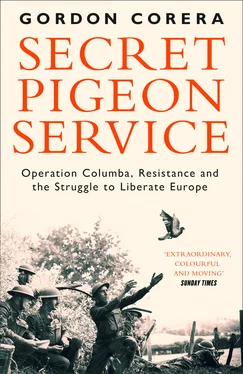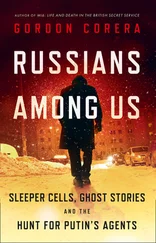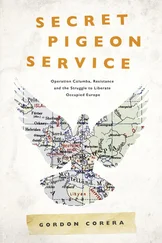This was how resistance often emerged in occupied Europe. Not as the result of activity from London on the part of British spies or exiles, but as groups of friends spontaneously coming together because they hated the German occupation and were desperate to do something about it. People would hang out in cafés, conspiring, starting to collect what they knew might be useful information about the enemy they could see around them, but often with no way of transmitting it to Britain. Now, suddenly, Columba presented some people with an opportunity. Could it act as a link to the nascent resistance?
And so, after a year of occupation, Raskin received the phone call from Arseen Debaillie. The next day he was there in the corner shop, in front of him the pigeon and the two sheets of rice paper, along with a patriotic appeal from Britain for help. He never had any doubts about what to do. Raskin, Hector Joye and the Debaillies made their decision. They would answer the call. They agreed amongst themselves that they would split up over the coming days to maximize the amount of information they could collect.
Arseen, the youngest of the brothers at the age of 27, nevertheless looked the oldest with his broad chubby face and glasses. He was the chief enthusiast and spy amongst the three brothers, although the family would work together as a team, its members supporting each other. Arseen spent the next few days driving along the coast and through the neighbourhoods around Bruges taking notes. Gabriel, thirty years old and the most anxious of the three brothers, would maintain the cover of working the family’s growing business – supplying animal feed at Roeselare. But he also went with his brother on a car trip to the coast, ostensibly for business but also to see what information they could gather.
Michel, the gangly pigeon fancier, tended to stay at home. The pigeon had arrived just a fortnight before his thirty-second birthday. As a child he had suffered from rheumatic heart fever, a condition which had left his heart damaged and required him to see a doctor every few weeks. His comfort, like those in Britain who had supported Columba, were his pigeons. Sundays were the days he liked to spend with his birds, often racing them at Lille. He kept them in a large, sideboard-sized coop on the ground floor of the building.
Hiding the British bird carried risks. Immediately after occupying Denmark, Norway, the Netherlands, Belgium and France, the Germans imposed controls on pigeon owners that were progressively tightened. In Belgium, the country’s Fédération des Colombophiles had to keep a register of every pigeon, and the Germans checked this regularly. Pigeon keeping would later be forbidden entirely in a number of districts in Belgium and northern France, matching closely the places where the Columba birds were dropped. Sometimes messages brought back by Columba pigeons revealed the pain this brought to those who loved their birds. One message reported a plea to British owners: ‘Rear a couple of young pigeons for me. I have to kill all mine.’ But Michel and the family were willing to take the risk. It was not too hard for him to hide one special bird that was different from the others.
Marie and Margaret, the two sisters, had their role. They would maintain the appearance that everything was normal at the shop, chatting away with customers while looking out for any signs of trouble. Raskin would go back to Brussels and gather material from there. He would also ask friends whom he trusted for any information they had.
Hector Joye had the time – and the cover – to travel. He had been a soldier in the First World War but while in the trenches he had been gassed by the Germans and was now invalided. During that war he had met Louise Legros, who worked for the Red Cross. Her well-to-do family had been opposed to their relationship, but one person who had encouraged them was Raskin. Theirs had been the first marriage he had conducted as a priest. Louise’s career had taken off and she had been appointed the director of a girls’ school in Bruges. The family lived in comfort in a house that was part of the grand, Gothic school complex. A family picture shows Raskin enjoying a lunch in comfortable surroundings with the Joye family all around – his visits were always the occasion for a party, events that the Joye children enjoyed.
Handsome, with swept-back fine dark hair, round glasses and a trim moustache, Joye was another tinkerer with similar hobbies to Raskin. He had once been a carpenter, had designed a heating system for some nuns and had built incubators for the eggs of the pheasants he kept. His finest invention, his son would remember, was a special Christmas tree mobile containing a mechanism that enabled the angels to fly around. As a former military engineer, he was fascinated by maps and fortifications. Like the others, he was a devout Catholic for whom serving God, king and country were as one. Because of his health, Joye had permission to travel up to the coast to get fresh air. With little to do (not least in comparison to his wife), Joye was enthusiastic at the opportunity to turn his hand to espionage.
The amateur spies needed to work fast. The pigeon could not be kept too long. But they were determined to make the most of their opportunity. The amount they collected was astonishing. They fanned out to discover what they could on their travels. Joye was the busiest. There was a particularly interesting chateau near Bruges occupied by German troops, he knew, and airports, and ammunition warehouses and factories producing material for the Wehrmacht. He would see what he could find. Arseen knew about the Bruges–Ghent railway line and a local aerodrome near their house, and could give details about the local population. Marie and Gabriel provided specific information about a nearby chateau. Raskin meanwhile seemed to have a stack of information ready to go. Some of this came from the network of contacts he had built up in Brussels, many of whom were women he knew through the church, and who were beginning, if haphazardly, to gather details of what they observed. Raskin tapped these friends for information. One letter to ‘my good Father’ from those days provides information about a German storage building in Brussels, and includes a drawing as well as details of munitions.
After days of frantic gathering, all the precious intelligence had to be squeezed into the two tiny sheets of rice paper the British had supplied with the pigeon. Raskin’s experience as a cartographer in the First World War and from China as a calligrapher meant he would be the one to write it all up. The Debaillies had just the place for him to work. Their corner shop was the public face of the business, where customers could come in and out. But the building was more of a mini-complex. There was an adjoining house where the family lived. And then, round the back of the shop, past a small, closed interior courtyard, was a structure used as a warehouse to store all the goods. At the beginning of the war, fearing German bombs, the family had built a windowless concrete room towards the back. Relatives would send their children out to Lichtervelde because it was thought less dangerous, and this room was their hiding place. The room had a bed in it where the children could sleep at times of danger, and a strong lock. It was what you might today call a safe room. It was perfect for spy-work.
A niece called Rosa, the daughter of another sister, was only eleven but was staying with the family. She was fond of Raskin. He wrote a rhyme, ‘Doosje van Roosje’ (little Rosa’s little box), on her sewing box and taught her to play the accordion the family had given him as a gift. She remembers Raskin was there more than normal during those days of July 1941. Something different was happening, she knew, but no one told her what it was. That would be too risky, in case she talked. She does remember one of her aunts – Marie, she thinks – heading into the safe room more often than she normally did.
Читать дальше












